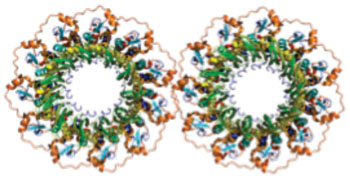Potential Drug Candidate Blocks Alternate DNA Repair Route in BRCA-Mutated Cancer Cells
By LabMedica International staff writers
Posted on 22 Nov 2015
Cancer researchers have identified a low molecular weight compound that inhibits the RAD52 DNA repair protein and kills cancer cells with a BRCA mutation by blocking the alternate DNA repair route.Posted on 22 Nov 2015
BRCA2 and BRCA1 are normally expressed in the cells of breast and other tissues, where they help repair damaged DNA or destroy cells if DNA cannot be repaired. They are involved in the repair of chromosomal damage with an important role in the error-free repair of DNA double strand breaks. If BRCA1 or BRCA2 itself is damaged by a BRCA mutation, damaged DNA is not repaired properly, and this increases the risk for breast cancer as well as for ovarian, prostate, pancreatic, and other cancers.
The protein product of the RAD52 (RAD52 homolog, DNA repair protein) gene binds single-stranded DNA ends, and mediates the DNA-DNA interaction necessary for the annealing of complementary DNA strands. It had been shown in earlier studies that suppression of RAD52 caused the death of BRCA-deficient cells. However, drugs capable of blocking RAD52 had not been identified.
To find a RAD52 inhibitor, investigators at Temple University (Philadelphia, PA, USA) screened more than 18,000 compounds. Eventually they identified 6-hydroxy-DL-dopa (6-OH-dopa) as the only small molecule (molecular weight 213.2) that consistently prevented RAD52 from binding to single-stranded DNA.
The investigators reported in the November 5, 2015, online edition of the journal Chemistry & Biology that multiple molecules of 6-OH-dopa bound to and completely transformed RAD52 undecamer rings into dimers, which abolished the ssDNA binding channel observed in crystal structures. In vitro experiments showed that 6-OH-dopa selectively inhibited the proliferation of BRCA-deficient cancer cells, including those obtained from leukemia patients. Normal cells with functioning BRCA were not affected by inhibition of RAD52.
"Every cell has redundant DNA repair pathways," said senior author Dr. Richard T. Pomerantz, assistant professor of medical genetics and molecular biochemistry at Temple University. "If the main DNA repair pathway, BRCA-mediated homologous recombination, becomes defective cancer cells adapt and still proliferate. The effect is like knocking out two legs of a table that normally is supported by four legs. One leg is lost to BRCA mutations and another to RAD52 inhibition. With only two legs left, the table collapses. Normal cells are left on three legs, due to only RAD52 inhibition, so they survive."
Related Links:
Temple University




![Image: Structure of 6-hydroxy-DL-dopa (6-OH-dopa) (Photo courtesy of the [US] National Institutes of Health). Image: Structure of 6-hydroxy-DL-dopa (6-OH-dopa) (Photo courtesy of the [US] National Institutes of Health).](https://globetechcdn.com/mobile_labmedica/images/stories/articles/article_images/2015-11-22/GMS-403b.jpg)










